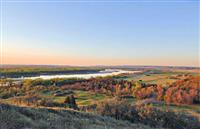 Fort Abraham Lincoln State Park
Fort Abraham Lincoln State Park
The original keepers of the land around Bismarck-Mandan were North Dakota’s Indian people. They were the Mandan, Hidatsa, Arikara, the Yanktonai, Sisseton, Wahpeton, Hunkpapa and other Dakotah/Lakotah (commonly known as the Sioux) tribes, along with the Pembina Chippewa, Cree and Metis.
This genuine Dakota spirit lives on in Bismarck-Mandan. Bismarck and Mandan were both established with the arrival of the transcontinental railroad.
Bismarck sprang up first when the Northern Pacific Railway reached the east bank of the Missouri River in 1873. As an inducement to have German capital invested in the railroad’s construction program, the Northern Pacific named Bismarck for German’s “Iron Chancellor,” Prince Otto Van Bismarck. Today, Bismarck is the center of government in North Dakota. Once the capital of Dakota Territory, Bismarck serves as the capital city of our state.
Mandan, named for the Mantani Indians, or "people of the bank," was founded as the center for western expansion for the iron rail. It was just south of Mandan, at Fort Abraham Lincoln, where Gen. George Custer left for the famous battle of the Little Bighorn in 1876. In 1883, a railroad bridge spanning the mighty Missouri River finally linked the east and west.
Today, the sister cities of Bismarck and Mandan continue as a trade and transportation hub. Normal services available here are comparable to cities with a population of 300,000. We have also become a thriving medical center. Energy has played an important role in the growth of Bismarck-Mandan. Many major energy companies have located here to pursue the development of oil, coal and synthetic fuels. Most recently, data processing and customer service centers have emerged in Bismarck-Mandan. In terms of a state-wide view, North Dakota's number one industry is agriculture followed by energy, then tourism.
Quick Facts:
| Location: |
South Central North Dakota, Bismarck is on the east side of the Missouri River and Mandan on the west side |
| Latitude: |
46 degrees, 46 minutes north |
| Longitude: |
100 degrees, 45 minutes west |
| Elevation: |
1,700 feet |
| Area: |
35.95 miles (Bismarck is 25.9 square miles and Mandan is 10.05 square miles) |
| Time Zone: |
Bismarck and Mandan are located in the Central Time Zone |
| MSA Population: |
134,846 |
|